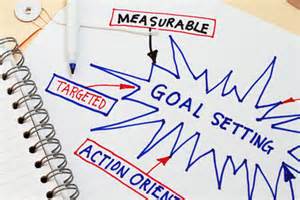Goal Analysis in 5 Simple Steps
By Dot Young
This is Part II in a two-part series.
In my last post we talked about the purpose of a Goal Analysis and why it is a good idea to perform one at the beginning of any project. You can read Part I here. In this post I will share the five steps that you can use to help ensure your goal is clarified into specific performance outcomes as outlined by Dr. Robert Mager, in his book, Goal Analysis: How to clarify your goals so you can actually achieve them.
As an Instructional Designer, it’s my job to develop performance support materials, like training courseware, to meet desired performance goals. Almost 99 percent of the time, this starts off with a generalized or vague statement, or what Dr. Mager terms a “fuzzy” goal. These are statements like, “I need them to…. be stronger leaders, be more customer-focused, think safety first, be more detail-oriented, value diversity, etc.”
There is nothing wrong with these goals, except there is no way to really know if they have been achieved. How will we know when someone values diversity, or is more detail-oriented or became a stronger leader? Until we can answer that, it will be extremely difficult to determine the actions needed to achieve it. Mager’s five-step process can help you turn fuzzy goals into measureable performance outcomes.
STEP 1 – Write Down the Goal
The first step is simply to write down the goal as it exists in current terms. If you are completing this in a group setting, it helps to write the goal on a white board or flipchart. It does not have to be long or complicated or even a complete sentence. For example: “get healthy” or “live a healthier lifestyle.”
STEP 2 – List Performances That Exemplify Goal Achievement
This is where you list what someone must do or say that represents achievement of the goal. In this step we want to answer the question, “How will I know when I see it?” During this step, write down everything that comes up. Do not edit or judge statements; that will be done later in the process. The purpose right now is to get everything down that indicates achievement of the goal.
This is often the hardest step, because many times you will get more “fuzzies.” Sometimes, especially at the beginning, it is easier to describe the goal using other vague words. For example, using the goal above of “get healthy,” you might get a list of things like “exercise more,” “eat right” or “lose weight,” as ways to recognize achievement of the goal. These are just as fuzzy as the original goal in their current form, but write them down anyway. It is important to write down everything. You can cross items off later, but you can’t cross off items that are not there.
Dr. Mager outlines several strategies for helping define “fuzzies” into observable performance in his book. Here are two that I find particularly helpful:
- If you had a group of people, how would you separate them into two groups: those who achieved the goal and those who had not? How will you tell who has and who has not?
- Think of a person who has already achieved the goal (or models the desired behavior) and write down all they say or what they do that would cause you to label them as representative of your goal. This works well with goal statements like “provide excellent customer service” or “have a good attitude.” It’s important to realize that if you cannot think of a real person who exemplifies your goal, you may need to re-evaluate the goal, as your expectations may not be realistic.
STEP 3 – Sort the List and Eliminate Any Remaining Fuzzies
Once you have a good list generated, you need to go back and review the items and their validity. This is when you will eliminate duplicates and define or eliminate any fuzzy statements.
- Place a check mark next to any item that does NOT qualify as a performance.
- Make sure remaining items describe outcomes and not processes. (“Make a cake” is an outcome-based statement, whereas “develop cake baking skills” is process-based.)
- For each fuzzy still remaining, write it down as a new goal and start the process again until you have a list of only performances.
In our example “get healthy” we had some additional fuzzies: “exercise more,” “eat right”or “lose weight.” These may be able to be turned into performances by simply adding parameters or measurements. “Exercise more” could be rewritten as: “Exercise a minimum of three times per week.” That might be one of the performances that would show achievement of the goal “get healthy.”
STEP 4 – Describe Performances in Complete Sentences
During this step of the process, take each performance that has been identified and write it as a complete sentence. This helps define or fine-tune what you really mean. For example, if our list under “get healthy” had “exercise more,” “lose weight” and “eat more fruits and vegetables” as performances, we could write them as follows:
To achieve the goal “Get Healthy” means to:
- Exercise 45 minutes per session, three sessions per week.
- Lose 10 pounds over the next three months.
- Eat a minimum of three servings of fruits and vegetables every day.
STEP 5 – Test for Completeness
The last step is to test for completeness by asking, “Am I willing to say the goal is achieved if I observe this list of performances?” If the answer is yes, then you are done with your goal analysis. If the answer is no, then you need to determine what performance is missing or perhaps needs to be defined further. Complete the above steps until you have the performances needed to call the goal achieved.
Give this process a try the next time you have an unclear goal and let us know: How did it work for you?
For a more in-depth look into this topic, you should read Dr. Robert Mager’s book, Goal Analysis: How to clarify your goals so you can actually achieve them, 3rd edition, published by the Center for Effective Performance, 1997.






As a corporate trainer I used Dr. Mager’s Goal Analysis in Train the Trainer. I also used Goal Analysis when consulting to aid a strategic planning effort. I’m retired now and I’m glad that Dr. Mager’s work is still relevant.